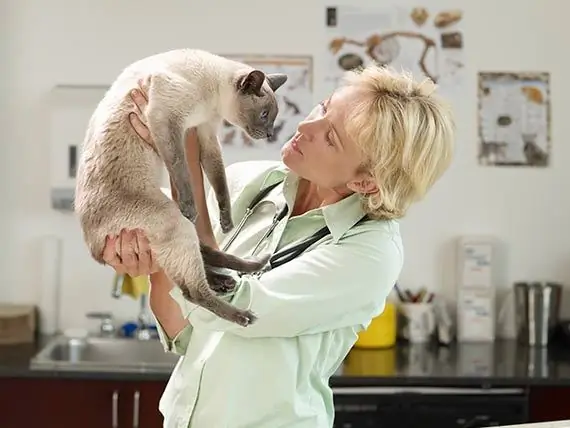
- Muallif Daisy Haig [email protected].
- Public 2023-12-17 03:15.
- Oxirgi o'zgartirilgan 2025-06-01 06:48.
Xo'sh, baribir bu kaka testi nima uchun?
Sizning chorva molingizning orqa tomoni plastik tayoq bilan buzilishi etarlicha stress, shunday emasmi? Xo'sh, nima gap?
Siz aytasiz: Agar maqsadim uy hayvonimni sog'lom va parazitsiz qilish bo'lsa, men sizning hukmingizga ishonaman, ammo aytishim kerakki, najasni tekshirish bu shafqatsiz va g'ayrioddiy jazo turidir. Men qirq yoshga to'lgunimcha bunday xo'rlikni olmayman, to'g'rimi? Va najaslar bu foydali emas, shunday emasmi?
Men aytaman: yangi boshlanuvchilar uchun sizning chorva molingiz qo'rqinchli tayoqqa berilmasligi kerak. Yangi namunani odatda yillik tashrifingizdan oldin yoki sizning chorva molingiz oshqozon-ichak trakti alomatlari bilan og'rigan har qanday vaqtda ertalab (yoki tushdan keyin) osongina olish mumkin. Bu, albatta, unchalik qiyin emas. Va agar vaqt to'liq to'g'ri kelmasa (yaxshi natija olish uchun najas bir soatdan oshmasligi kerak), sizning veterinariya shifoxonasi sizga qulay sharoitda o'ta yangi namunani olib kelish huquqini inkor etmasligi aniq. Va'da.
Ha, najas tekshiruvlari, nisbatan arzon va odatiy bo'lishiga qaramay, ajralmas hisoblanadi. Ammo ushbu xabar ko'rsatilgandek, barcha najas sinovlari sizning uy hayvonlarida parazit infektsiyasini yuqtirmasligi ham haqiqat. Shuning uchun yillik va / yoki ketma-ket najas tekshiruvlari zarur bo'lishi mumkin.
Endi testning asosiy maqsadi uchun:
Veterinariya shifokorlari har doim sizning chorva mollaringizning oshqozon-ichak traktiga kirib borishi mumkin bo'lgan parazitlarni qidirishadi. Albatta, biz odamlar ham parazitlar bilan kasallanishimiz mumkin, ammo bizning zamonaviy turmush tarzimiz parazit infektsiyasiga unchalik mos kelmaydi. (Oxirgi marta qachon siz bir yoki ikkita mushukning turdini nafas olish uchun hovlida lablarini erga tekkizgansiz?)
Ha, uy hayvonlari ko'plab parazitlarni oladi. Bu erda men ko'rgan eng keng tarqalgan oshqozon-ichak parazitlaridan namunalar [Janubiy Florida yarim tropik bo'lgan parazit osmonida]:
Itlar va mushuklardagi yumaloq qurtlar.
Uy hayvonlarida ankilomitlar
Uy hayvonlarida qamchi qurtlari
Uy hayvonlarida Giardia

Jigar uy hayvonlarida yuqadi
Jigar uy hayvonlarida yuqadi
coccidia in pets
i’ll not go into the gory details on each but you can click on the links and check out the info for a better understanding of how these parasites can potentially affect your pets and even your human family.
sure, pet-popular parasites don’t often infect humans in the so-called, “developed” nations all of you reading this likely live in, but that doesn’t mean it doesn’t happen. roundworms and hookworms are still a factor in humans in the us, as is giardia, which will give you the nastiest case of diarrhea you can imagine short of amoebic dysentery.
since veterinarians are also on the front lines when it comes to public health, consider that fecal exams are not just necessary for healthy pets, they’re essential for healthy humans, too, more so if your family members are very young children, very old adults or otherwise immunocompromised (transplant patients, hiv-positive humans, chemo recipients, etc.).
how do we identify these critters in the fecal exam?
the short answer: with a microscope.
the long answer: we take a tiny sample of your pet’s stool (very fresh is always best). a few grams is enough (think an eighth of a teaspoon if that’s easier). then we put it through one of three processes.
1. the smear: we take about a half gram of stool and smear it onto a microscope slide to search for parasites (and bacteria) directly. many times we’ll see them swimming about. finding evidence of parasites in a simple smear is often indicative of severe infection.
2. the float: this method relies on mixing the stool with a special solution. it filters out the big pieces of stool in a tube or other cylindrical vessel and allows the eggs and other small critters to float up to the top, buoyed by the solution’s specific gravity. a microscope slide’s cover slip is typically used to recover the floaters. some parasites, however, aren’t amenable to flotation. eggs seem to do best through this method.
3. centrifugation: spinning the heck out of stool in a centrifuge when it’s mixed in a sugar solution picks up about 50% more parasite eggs and oocysts than through flotation. therefore, i like this method best for worm eggs, giardia, and coccidia--though i’d never go without a smear. problem is, most hospitals don’t yet use this method. it’s more expensive than others and research demonstrating it’s much greater efficacy is fairly recent.
so now you know the truth: not all fecal exams are created equal. not only does this test rely on careful selection of materials and methods, it also requires a trained eye. in our practice, for example, one of our techs detects parasites about 50% more often than the veterinarians and other techs/assistants. (that’s why we also do floats so that she can check them all at her convenience when she comes back from her day off.)
it’s also true that even a parasite-infected animal will often not come up positive on a fecal test. human error and equipment choice are factors, but so is the parasite itself. sometimes they do not make themselves known in the stool. worms sometimes aren’t shedding their eggs and subclinical (low-grade or smoldering) infections may not reveal much, either.
again, that’s why it’s important to perform this test as often as is reasonable. for all dogs and cats at least three times during the first few months of life. i want to see at least two negative tests in a row, a month apart, before i’ll feel comfortable that my patient is parasite-free.
for adults, once a year is great--that is, unless they show gastrointestinal illnesses. in this case, serial fecal tests make sense--or at least one every time the symptoms recur until a definitive diagnosis is made (whether it’s parasites or something else).
ultimately, fecal tests are a critical component of our veterinary hat of tricks. doing without may seem like the economically wisest thing in the absence of gastrointestinal symptoms, but consider: parasites can wear pets down in ways you might not expect. and it’s never wrong to be too safe in the presence of diseases that may also affect your family. ‘nuff said.
Tavsiya:
Titer Testi Nima Va U Sizning Chorva Molingiz Uchun To'g'ri Emasmi?

Jamiyatning tobora ko'payib borayotgan tashvishlariga qarshi turish va ba'zi vaktsinalar ba'zi uy hayvonlariga salbiy ta'sir ko'rsatishi mumkinligiga oid dalillarni ko'rib chiqish uchun emlash zarurligini aniqlash uchun ishlatiladigan tibbiy muolajalardan biri titer testidir. Bu erda ko'proq ma'lumot oling
Sizning Chorva Molingiz Tomonidan Sizning Chorva Molingiz Prognozini Qanday Aniqlaydi

"Biz aniq prognostik omillarga ko'proq e'tibor qaratsak, biz katta rasmni unutamiz". Doktor Intile o'z bemorlarini parvarish qilish bo'yicha tavsiyalar berishdan oldin, har bir hayvon noyob yaratilgan organizm ekanligini va ko'plab omillarni o'lchash kerakligini eslashga qaratadi. Uy hayvoningizning "prognostik omillari" va ular davolanishni qanday belgilashi haqida ko'proq ma'lumot oling Daily Vet
Qon Bilan Ishlash: Bu Nimani Anglatadi Va Sizning Chorva Molingiz Unga Nima Uchun Kerak (1 Qism: CBC)

"Uning qonini stomatologiyadan oldin sinab ko'rish uchun 99 dollar kerakmi? Jiddiymi? Menimcha, biz butun stomatologik narsani o'tkazib yuboramiz. Anesteziya baribir meni g'azablantiradi.” Odatda men ishlaydigan joyga qanday qilib bu shunday emas. M
Qon Bilan Ishlash: Bu Nimani Anglatadi Va Sizning Chorva Molingiz Unga Nima Uchun Kerak (2 Qism: Qon Kimyosi)

Ushbu mavzu Dolittlerda bug 'yig'ib oladi - bu hayvonot vositalarining veterinariya xayollarida bo'lgani kabi. Shuning uchun ushbu mavzu to'g'ri hal qilish uchun ikki postli davolanishni talab qiladi. Qon bilan ishlash har bir uy hayvonining tibbiy yordamining tobora keng tarqalgan tarkibiy qismi bo'lishiga qaramay, har bir veterinar sizning chorva molingiz qonini avtomatik ravishda tortib olmaydi
Sizning Chorva Molingiz Nekropsiyaga Muhtojligini Qanday Bilsa Bo'ladi (va Baribir Nekropsi Nima?)

Nekropiya, hayvonlarni otopsi, uy hayvonlari, it, mushuk
